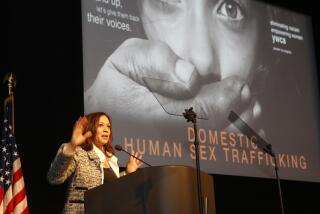Op-Ed: A study of California prosecutors finds a lack of diversity
In one police killing after another over the last year, as the nation has waited to find out if charges would be filed against officers, we’ve been reminded that prosecutors are in many ways the most powerful officials in the American criminal justice system.
Prosecutors decide whether to bring a case before a grand jury, how hard to press for an indictment, what charges to request and how punitive a sentence to recommend. Grand juries almost never refuse to file the charges prosecutors request. And mandatory sentencing laws often allow prosecutors to determine the penalty by picking the charges.
Moreover, the vast majority of criminal cases in the United States end in plea bargains, not in trials. So the discretion exercised in our justice system is mostly not by judges but by prosecutors, and typically not by elected district attorneys but by the legions of far less visible lawyers they employ.
Who are they? How representative are assistant district attorneys and deputy district attorneys of the communities they serve? For the most part, the answer is “we don’t know.” Race and gender statistics for police officers have been publicly available for decades, but nothing similar has existed for prosecutors.
Working with law students at Stanford University, we set out to fill that gap for California. We eventually obtained data for 52 of California’s 58 counties, collectively including more than 98% of the state’s population. What we found should trouble anyone who cares about criminal justice.
Latinos recently surpassed whites as the largest demographic group in California. Police departments are struggling to keep pace: 28% of law enforcement officers in California today are Latino. But that is more than three times better than district attorneys’ offices: Only 9% of California prosecutors are Latino.
Whites are slightly more than 38% of the California population and 55% of the state’s law enforcement officers. Again, prosecutors make the police look good: 70% of California prosecutors are white. The last year that 70% of California was white was 1977, when Jimmy Carter was sworn in as president, Apple Computer was incorporated and the original “Star Wars” movie was released.
There was some good news in what we found. African Americans are not underrepresented among California prosecutors, although that is partly because the number required to meet that mark is relatively low, given that blacks are just 6% of the state’s population. We also found that close to half of all California prosecutors — 48% — are female, although the figure drops to 41% in supervisory ranks. (Police departments are much worse when it comes to gender equity: Only 13% of law enforcement officers in California are female.)
Our study did not analyze how workforce diversity in prosecutors’ offices influences the outcome of criminal cases. But other researchers have found that when racial minorities are underrepresented among prosecutors, minority defendants receive stiffer sentences. And researchers have shown that respect for the law and trust in legal institutions are undermined when criminal justice agencies do not reflect the communities they serve.
Why are California prosecutors so unrepresentative of the state? One reason is the pool from which prosecutors must be hired: lawyers. The California bar is even whiter than the state’s prosecutors. Nearly 80% of California lawyers are white; only 6% are Latino. Those figures are changing, but slowly: 64% of law students in California are white; 14% are Latino.
California prosecutors are likely not any less diverse than prosecutors in many other parts of the United States. And federal prosecutors may not be much better. Data we obtained through a Freedom of Information Act request indicate that, nationwide, 8% of assistant U.S. attorneys are African American and 5% are Latino, compared with a national population that is 13% African American and 17% Latino. And only 38% of assistant U.S. attorneys are women. (Not all assistant U.S. attorneys are prosecutors; some work on civil rather than criminal cases.)
Diversifying prosecutors’ offices is not just a job for prosecutors. It is a task for law schools and state bars as well. But prosecutors must do their share, and that begins with transparency. Just as police departments routinely report their demographics, prosecutors should be open about the composition of their offices. Knowing who is exercising judgment in our justice system is crucial to the debate about how to make the system fairer.
Debbie Mukamal is the executive director of the Stanford Criminal Justice Center. David Alan Sklansky is a professor at Stanford Law School and a faculty co-director of the Stanford Criminal Justice Center.
Follow the Opinion section on Twitter @latimesopinion and Facebook
More to Read
A cure for the common opinion
Get thought-provoking perspectives with our weekly newsletter.
You may occasionally receive promotional content from the Los Angeles Times.










